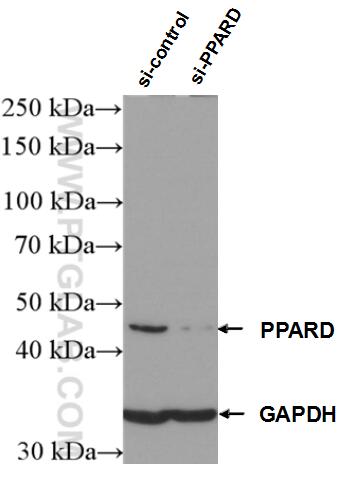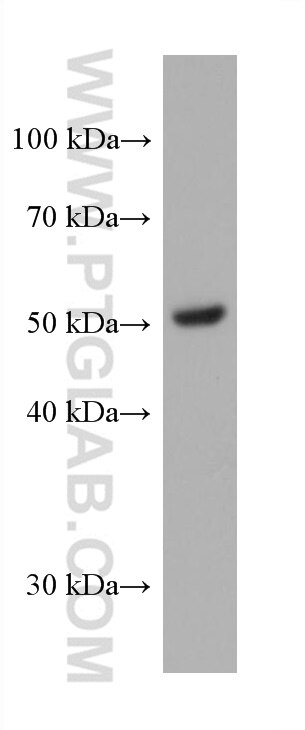- Phare
- Validé par KD/KO
Anticorps Monoclonal anti-PPARD
PPARD Monoclonal Antibody for WB, ELISA
Hôte / Isotype
Mouse / IgG2a
Réactivité testée
Humain, porc et plus (3)
Applications
WB, IHC, ChIP, ELISA
Conjugaison
Non conjugué
CloneNo.
1B10E1
N° de cat : 60193-1-Ig
Synonymes
Galerie de données de validation
Applications testées
| Résultats positifs en WB | cellules HeLa, cellules A549, cellules Jurkat, cellules K-562, tissu adipeux de porc |
Dilution recommandée
| Application | Dilution |
|---|---|
| Western Blot (WB) | WB : 1:1000-1:6000 |
| It is recommended that this reagent should be titrated in each testing system to obtain optimal results. | |
| Sample-dependent, check data in validation data gallery | |
Applications publiées
| KD/KO | See 1 publications below |
| WB | See 13 publications below |
| IHC | See 1 publications below |
| ChIP | See 1 publications below |
Informations sur le produit
60193-1-Ig cible PPARD dans les applications de WB, IHC, ChIP, ELISA et montre une réactivité avec des échantillons Humain, porc
| Réactivité | Humain, porc |
| Réactivité citée | rat, Humain, poisson-zèbre, souris |
| Hôte / Isotype | Mouse / IgG2a |
| Clonalité | Monoclonal |
| Type | Anticorps |
| Immunogène | PPARD Protéine recombinante Ag16770 |
| Nom complet | peroxisome proliferator-activated receptor delta |
| Masse moléculaire calculée | 50 kDa |
| Poids moléculaire observé | 54 kDa |
| Numéro d’acquisition GenBank | BC002715 |
| Symbole du gène | PPARD |
| Identification du gène (NCBI) | 5467 |
| Conjugaison | Non conjugué |
| Forme | Liquide |
| Méthode de purification | Purification par protéine A |
| Tampon de stockage | PBS with 0.02% sodium azide and 50% glycerol |
| Conditions de stockage | Stocker à -20°C. Stable pendant un an après l'expédition. L'aliquotage n'est pas nécessaire pour le stockage à -20oC Les 20ul contiennent 0,1% de BSA. |
Informations générales
Peroxisome proliferator-activator receptor delta(PPARD), a ligand-activated transcription factor, belongs to the PPARs family, which get its name for their chemicals that induce proliferation of peroxisomes, organelles that contributes to the oxidation of fatty acids. PPARD is a receptor for peroxisome proliferator and once activated by a ligand, it binds to and activates the promoter elements of target genes, such as acylCoA oxidase gene. But it act as a repressor for the NPC1L1 gene.
Protocole
| Product Specific Protocols | |
|---|---|
| WB protocol for PPARD antibody 60193-1-Ig | Download protocol |
| Standard Protocols | |
|---|---|
| Click here to view our Standard Protocols |
Publications
| Species | Application | Title |
|---|---|---|
Liver Int PPARβ/δ activation protects against hepatic ischaemia-reperfusion injury
| ||
Am J Physiol Endocrinol Metab Zinc finger protein 407 overexpression upregulates PPAR target gene expression and improves glucose homeostasis in mice | ||
Front Aging Neurosci A tau fragment links depressive-like behaviors and cognitive declines in Alzheimer's disease mouse models through attenuating mitochondrial function | ||
Front Biosci (Landmark Ed) Trimetazidine: Activating AMPK Signal to Ameliorate Coronary Microcirculation Dysfunction after Myocardial Infarction | ||
Nat Commun Axin formation inhibitor 1 aggravates hepatic ischemia‒reperfusion injury by promoting the ubiquitination and degradation of PPARβ |




